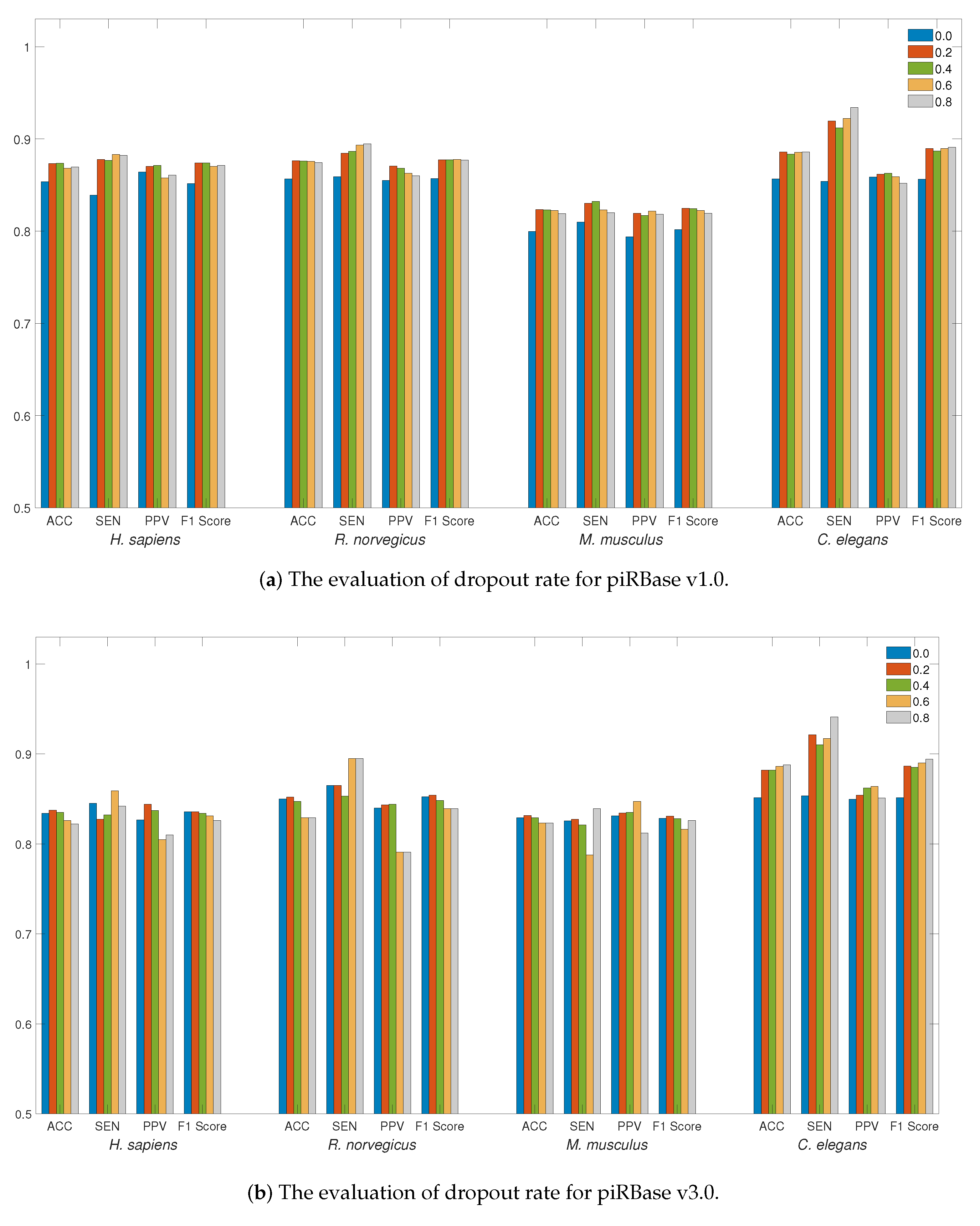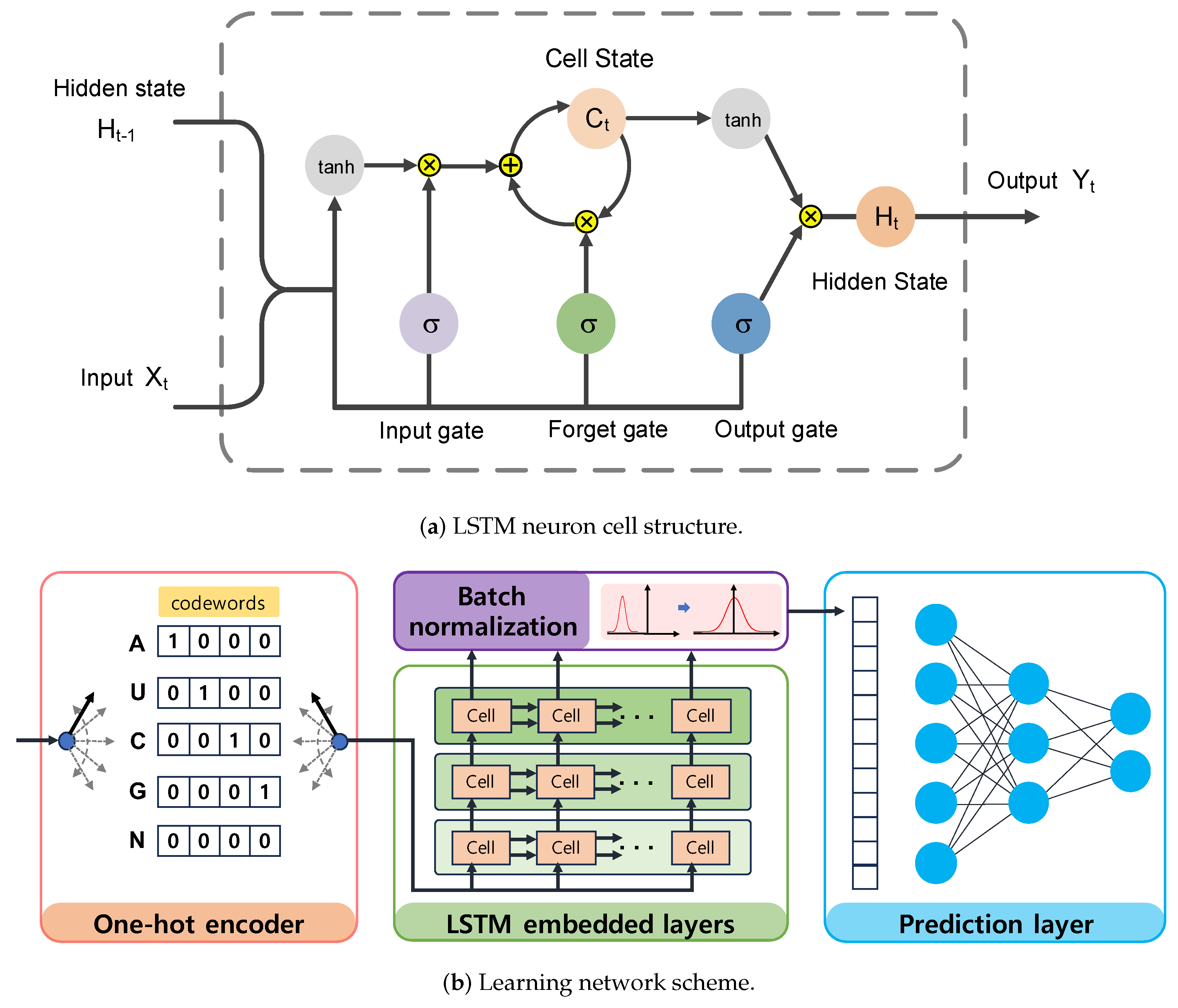LSTM4piRNA: Efficient piRNA Detection in Large-Scale Genome Databases Using a Deep Learning-Based LSTM Network
Abstract
:1. Introduction
2. Results
2.1. Regularization and Generalization
2.2. Accurate Prediction of piRNA Sequences
3. Discussion
4. Materials and Methods
4.1. Encode Data and Generalization
4.2. Network Architecture and Regularization
Author Contributions
Funding
Institutional Review Board Statement
Informed Consent Statement
Data Availability Statement
Conflicts of Interest
Abbreviations
| LSTM | Long Short-Term Memory |
| piRNA | Piwi-interacting RNAs |
| PPV | Positive Predictive Value |
| SEN | Sensitivity |
| ACC | Accuracy |
References
- Aravin, A.A.; Hannon, G.J.; Brennecke, J. The Piwi-piRNA pathway provides an adaptive defense in the transposon arms race. Science 2007, 318, 761–764. [Google Scholar] [CrossRef] [PubMed]
- Weick, E.M.; Miska, E.A. piRNAs: From biogenesis to function. Development 2014, 141, 3458–3471. [Google Scholar] [CrossRef] [PubMed]
- Juliano, C.; Wang, J.; Lin, H. Uniting germline and stem cells: The function of Piwi proteins and the piRNA pathway in diverse organisms. Annu. Rev. Genet. 2011, 45, 447–469. [Google Scholar] [CrossRef]
- Mei, Y.; Clark, D.; Mao, L. Novel dimensions of piRNAs in cancer. Cancer Lett. 2013, 336, 46–52. [Google Scholar] [CrossRef] [PubMed]
- Ng, K.W.; Anderson, C.; Marshall, E.A.; Minatel, B.C.; Enfield, K.S.; Saprunoff, H.L.; Lam, W.L.; Martinez, V.D. Piwi-interacting RNAs in cancer: Emerging functions and clinical utility. Mol. Cancer 2016, 15, 5. [Google Scholar] [CrossRef]
- Shi, S.; Yang, Z.Z.; Liu, S.; Yang, F.; Lin, H. PIWIL1 promotes gastric cancer via a piRNA-independent mechanism. Proc. Natl. Acad. Sci. USA 2020, 117, 22390–22401. [Google Scholar] [CrossRef]
- Kolliopoulou, A.; Santos, D.; Taning, C.N.T.; Wynant, N.; Vanden Broeck, J.; Smagghe, G.; Swevers, L. PIWI pathway against viruses in insects. Wiley Interdiscip. Rev. RNA 2019, 10, e1555. [Google Scholar] [CrossRef]
- Lakshmi, S.S.; Agrawal, S. piRNABank: A web resource on classified and clustered Piwi-interacting RNAs. Nucleic Acids Res. 2008, 36, D173–D177. [Google Scholar] [CrossRef]
- Zhang, P.; Si, X.; Skogerbø, G.; Wang, J.; Cui, D.; Li, Y.; Sun, X.; Liu, L.; Sun, B.; Chen, R.; et al. piRBase: A web resource assisting piRNA functional study. Database 2014, 2014, bau110. [Google Scholar] [CrossRef]
- Seto, A.G.; Kingston, R.E.; Lau, N.C. The coming of age for Piwi proteins. Mol. Cell 2007, 26, 603–609. [Google Scholar] [CrossRef]
- Betel, D.; Sheridan, R.; Marks, D.S.; Sander, C. Computational analysis of mouse piRNA sequence and biogenesis. PLoS Comput. Biol. 2007, 3, e222. [Google Scholar] [CrossRef]
- Zhang, Y.; Wang, X.; Kang, L. A k-mer scheme to predict piRNAs and characterize locust piRNAs. Bioinformatics 2011, 27, 771–776. [Google Scholar] [CrossRef]
- Chen, C.C.; Qian, X.; Yoon, B.J. Effective computational detection of piRNAs using n-gram models and support vector machine. BMC Bioinform. 2017, 18, 103–109. [Google Scholar] [CrossRef] [PubMed]
- Wang, K.; Hoeksema, J.; Liang, C. piRNN: Deep learning algorithm for piRNA prediction. PeerJ 2018, 6, e5429. [Google Scholar] [CrossRef] [PubMed]
- Li, D.; Luo, L.; Zhang, W.; Liu, F.; Luo, F. A genetic algorithm-based weighted ensemble method for predicting transposon-derived piRNAs. BMC Bioinform. 2016, 17, 329. [Google Scholar] [CrossRef] [PubMed]
- Rosenkranz, D.; Zischler, H. proTRAC-a software for probabilistic piRNA cluster detection, visualization and analysis. BMC Bioinform. 2012, 13, 5. [Google Scholar] [CrossRef]
- Jung, I.; Park, J.C.; Kim, S. piClust: A density based piRNA clustering algorithm. Comput. Biol. Chem. 2014, 50, 60–67. [Google Scholar] [CrossRef]
- Brayet, J.; Zehraoui, F.; Jeanson-Leh, L.; Israeli, D.; Tahi, F. Towards a piRNA prediction using multiple kernel fusion and support vector machine. Bioinformatics 2014, 30, i364–i370. [Google Scholar] [CrossRef]
- Boucheham, A.; Sommard, V.; Zehraoui, F.; Boualem, A.; Batouche, M.; Bendahmane, A.; Israeli, D.; Tahi, F. IpiRId: Integrative approach for piRNA prediction using genomic and epigenomic data. PloS ONE 2017, 12, e0179787. [Google Scholar] [CrossRef]
- Wang, J.; Shi, Y.; Zhou, H.; Zhang, P.; Song, T.; Ying, Z.; Yu, H.; Li, Y.; Zhao, Y.; Zeng, X.; et al. piRBase: Integrating piRNA annotation in all aspects. Nucleic Acids Res. 2022, 50, D265–D272. [Google Scholar] [CrossRef]
- Hochreiter, S.; Schmidhuber, J. Long short-term memory. Neural Comput. 1997, 9, 1735–1780. [Google Scholar] [CrossRef] [PubMed]
- Gers, F.A.; Schmidhuber, E. LSTM recurrent networks learn simple context-free and context-sensitive languages. IEEE Trans. Neural Netw. 2001, 12, 1333–1340. [Google Scholar] [CrossRef] [PubMed]
- Griffiths-Jones, S.; Bateman, A.; Marshall, M.; Khanna, A.; Eddy, S.R. Rfam: An RNA family database. Nucleic Acids Res. 2003, 31, 439–441. [Google Scholar] [CrossRef] [PubMed]
- Kalvari, I.; Nawrocki, E.P.; Ontiveros-Palacios, N.; Argasinska, J.; Lamkiewicz, K.; Marz, M.; Griffiths-Jones, S.; Toffano-Nioche, C.; Gautheret, D.; Weinberg, Z.; et al. Rfam 14: Expanded coverage of metagenomic, viral and microRNA families. Nucleic Acids Res. 2021, 49, D192–D200. [Google Scholar] [CrossRef]
- Ioffe, S.; Szegedy, C. Batch normalization: Accelerating deep network training by reducing internal covariate shift. In Proceedings of the International Conference on Machine Learning, PMLR, Lille, France, 6–11 July 2015; pp. 448–456. [Google Scholar]
- Kingma, D.P.; Ba, J. Adam: A method for stochastic optimization. arXiv 2014, arXiv:1412.6980. [Google Scholar]
- Srivastava, N.; Hinton, G.; Krizhevsky, A.; Sutskever, I.; Salakhutdinov, R. Dropout: A simple way to prevent neural networks from overfitting. J. Mach. Learn. Res. 2014, 15, 1929–1958. [Google Scholar]
- Baldi, P.; Sadowski, P. The dropout learning algorithm. Artif. Intell. 2014, 210, 78–122. [Google Scholar] [CrossRef]



| Method | H. sapiens | ||||
|---|---|---|---|---|---|
| ACC | SEN | PPV | F1-Score (%) | Log (Time) | |
| LSTM4piRNA | 88.66 | 89.86 | 87.75 | 88.79 | 1.05 |
| piRNAPredictor | 77.79 | 81.36 | 75.94 | 78.56 | 1.76 |
| GAWE | 80.35 | 82.13 | 79.31 | 80.70 | 3.66 |
| piRNN | 86.88 | 87.82 | 86.20 | 87.00 | 2.24 |
| R. norvegicus | |||||
| LSTM4piRNA | 88.50 | 88.88 | 88.22 | 88.55 | 1.12 |
| piRNAPredictor | 74.91 | 83.15 | 71.39 | 76.82 | 1.99 |
| GAWE | 87.07 | 89.85 | 85.13 | 87.42 | 3.98 |
| piRNN | 87.27 | 88.43 | 86.43 | 87.42 | 2.52 |
| M. musculus | |||||
| LSTM4piRNA | 83.34 | 84.07 | 82.86 | 83.46 | 1.28 |
| piRNAPredictor | 73.19 | 78.02 | 71.15 | 74.42 | 2.23 |
| GAWE | 80.00 | 80.50 | 79.70 | 80.10 | 4.12 |
| piRNN | 81.51 | 80.44 | 82.20 | 81.31 | 2.70 |
| C. elegans | |||||
| LSTM4piRNA | 89.25 | 93.80 | 85.98 | 89.72 | 1.12 |
| piRNAPredictor | 78.10 | 79.05 | 77.58 | 78.31 | 1.66 |
| GAWE | 84.30 | 88.47 | 81.65 | 84.93 | 3.18 |
| piRNN | 87.69 | 91.42 | 85.07 | 88.13 | 2.11 |
| Method | H. sapiens | ||||
|---|---|---|---|---|---|
| ACC | SEN | PPV | F1-Score (%) | Log (Time) | |
| LSTM4piRNA | 83.81 | 82.81 | 84.49 | 83.64 | 1.87 |
| piRNAPredictor | 70.59 | 73.09 | 69.61 | 71.31 | 3.22 |
| R. norvegicus | |||||
| LSTM4piRNA | 85.25 | 85.57 | 85.03 | 85.30 | 1.55 |
| piRNAPredictor | 72.53 | 70.30 | 73.58 | 71.90 | 3.18 |
| M. musculus | |||||
| LSTM4piRNA | 83.32 | 82.90 | 83.61 | 83.25 | 1.79 |
| piRNAPredictor | 71.77 | 69.05 | 73.02 | 70.98 | 3.21 |
| C. elegans | |||||
| LSTM4piRNA | 88.81 | 92.32 | 86.27 | 89.19 | 1.10 |
| piRNAPredictor | 78.25 | 79.39 | 77.62 | 78.50 | 1.62 |
| GAWE | 82.20 | 85.03 | 80.47 | 82.69 | 3.20 |
| piRNN | 87.45 | 92.11 | 84.26 | 88.01 | 2.14 |
| piRBase v1.0 | Data Size | Average Length |
|---|---|---|
| H. sapiens | 32,252 | 28.8 |
| R. norvegicus | 62,130 | 28.1 |
| M. musculus | 100,000 | 26.9 |
| C. elegans | 28,219 | 21.0 |
| piRBase v3.0 | Data Size | Average Length |
| H. sapiens | 1,000,000 | 28.5 |
| R. norvegicus | 1,000,000 | 28.0 |
| M. musculus | 1,000,000 | 27.2 |
| C. elegans | 30,036 | 21.0 |
| Nucleotide Base | One-Hot Vector |
|---|---|
| A | [1,0,0,0] |
| U | [0,1,0,0] |
| C | [0,0,1,0] |
| G | [0,0,0,1] |
| N | [0,0,0,0] |
Disclaimer/Publisher’s Note: The statements, opinions and data contained in all publications are solely those of the individual author(s) and contributor(s) and not of MDPI and/or the editor(s). MDPI and/or the editor(s) disclaim responsibility for any injury to people or property resulting from any ideas, methods, instructions or products referred to in the content. |
© 2023 by the authors. Licensee MDPI, Basel, Switzerland. This article is an open access article distributed under the terms and conditions of the Creative Commons Attribution (CC BY) license (https://creativecommons.org/licenses/by/4.0/).
Share and Cite
Chen, C.-C.; Chan, Y.-M.; Jeong, H. LSTM4piRNA: Efficient piRNA Detection in Large-Scale Genome Databases Using a Deep Learning-Based LSTM Network. Int. J. Mol. Sci. 2023, 24, 15681. https://doi.org/10.3390/ijms242115681
Chen C-C, Chan Y-M, Jeong H. LSTM4piRNA: Efficient piRNA Detection in Large-Scale Genome Databases Using a Deep Learning-Based LSTM Network. International Journal of Molecular Sciences. 2023; 24(21):15681. https://doi.org/10.3390/ijms242115681
Chicago/Turabian StyleChen, Chun-Chi, Yi-Ming Chan, and Hyundoo Jeong. 2023. "LSTM4piRNA: Efficient piRNA Detection in Large-Scale Genome Databases Using a Deep Learning-Based LSTM Network" International Journal of Molecular Sciences 24, no. 21: 15681. https://doi.org/10.3390/ijms242115681
APA StyleChen, C.-C., Chan, Y.-M., & Jeong, H. (2023). LSTM4piRNA: Efficient piRNA Detection in Large-Scale Genome Databases Using a Deep Learning-Based LSTM Network. International Journal of Molecular Sciences, 24(21), 15681. https://doi.org/10.3390/ijms242115681






